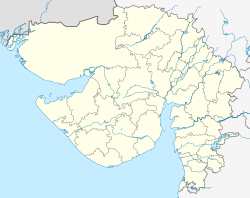Legends
The town is mentioned in Mahabharata and Bhavishottar Puran as 'Ilvadurg'. The exact date of its origin is not known; but it is believed that it came into existence at the time when Yudhishthira was ruling over Hastinapur at the end of the Kurukshetra War of Mahabharata. [2]
According to tradition, Idar has been celebrated from the earliest times. Even in the past cycle, yuga , it was known, and in the present cycle, before the days of Vikram, the legendary king Veni Vachh Raj ruled at Idar, the possessor of a golden figure which helped him to build the hillfort and its reservoirs. His queen was a Nagputri, the daughter of a snake-king of the under world, whither, the legend says, she and her consort betook themselves when the queen found that men were mortal. [4]
Ancient history
The first clear tradition shows Idar in the possession of Bhils. Raja Mandlik Bhil was King of Ider. After the fall of Vallabhi in 770, Kamalavati or Pushpavati, one of the wives of Maitraka king Shiladitya was at Ambaji to fulfil a vow. She heard news and took refuge in a cave in the mountains and there gave birth to a son called Gruhaditya or 'Goha', meaning cave-born. [5] Making over the child to a Brahmin woman, the queen followed her husband through the fire. The young prince, of a daring character and adventurous spirit, soon passed out of his guardian's hands, and joining the Idar Bhils was by them chosen king. Whether in sport or earnest, the election was real, and for several generations his successors ruled in Idar. At last Nagaditya or Aparajita the eighth prince was killed by his subjects. He left a son named Bappa Rawal who never succeeded to his father's chiefship, but became the founder of Mewar dynasty. [6] The Chinese pilgrim Xuanzang (640) mentions a place which he calls O-clia-li, the Chinese way of writing Vadali, a village nearby. British General Cunningham identified this place with Idar. He further noted that in the eleventh century Vadali or Vadari was the capital of a family of chiefs claiming descent from Raja Bhara Gupta, whom the General believed to be the same as the above-mentioned Bappa. According to tradition, Idar was refounded by Parihar Rajputs, who, subject to Chittor, ruled there for several generations. Towards the close of the twelfth century, the Idar chief took part with Prithviraj Chauhan, king of Delhi, against the Ghurid Sultanate and was killed in the Battles of Tarain (1192). Idar then fell into the hands of a Bhil [7] king named Hathi Sord who founded the Sord dynasty and was succeeded by his son Samalio Bhil. The latter was killed by a Rathod prince named Sonangji, who took occupied Idar, and became the founder of the dynasty of the Raos who ruled there for several generations. After numerous changes of fortune and many struggles with the Muslims, the Raos had at last to leave Idar, and were, in 1728, succeeded by the Rathod dynasty from Marwar. [4]










